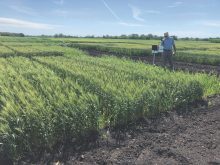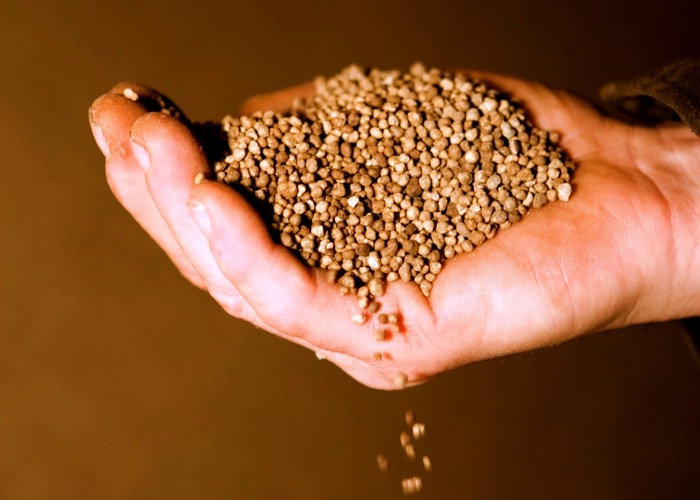Farmers need a stronger voice in the supply chain to balance the commercial system.
That’s what Dr. Brian Oleson told delegates at Fields on Wheels in December. Oleson specializes in co-operatives and marketing at the University of Manitoba.
Oleson saw the Canadian Wheat Board as the farmer representative in the supply chain, he told delegates. In an interview at the conference, Oleson said farmers have lost their voice in the supply chain.
He’s not suggesting farmers try to turn back the clock. But in an industry dominated by railways and grain companies, farmers do need to make sure the grain handling system can move the increasing production in the future, Oleson explained.
Read Also

Gentle treatments for pain in the neck
Heading toward year-end, people unknowingly tense up against the cold and busyness, causing neck pain that can often be treated with appropriate support and gentle mobility, athletic therapist Kathlyn Hossack says.
“It’s absolutely critical,” he said.
When I asked how farmers can come to enough of a consensus to do this, Oleson acknowledged it wouldn’t be easy. But farmers need to take a close look at their farm organizations because they’re not part of the value chain right now, he said. Farmers need to take this seriously and “make sure (farm organizations are) as strong as possible in terms of carrying their views and their interests.”
Leadership is like boxing
Building leadership ability is like boxing, minus the punching
A few weeks ago I was at our local boxing club. The coach was talking to the kids about strategy in the ring. Boxing builds character, he told them, because you need to be patient and watch for a chance to make your move.
Building leadership ability is similar (but without the actual punching). It takes time to develop skills. It requires patience and commitment. It can be a real slog sometimes, and you might wonder if it’s worth it. But then, one day, a big issue pops up. If you’ve put in your time at the gym, you’ll be ready to make your move. If you’ve been sitting on the couch, it’s going to be rough.
Recruiting new blood to farm organizations is easier said than done, I’m sure. Young farmers are busy with farming and family. One or both spouses might have off-farm jobs. Volunteering for a board is a tough sell.
I think the first step is just getting people involved. Get potential members to a conference. Make sure both green and veteran members benefit from programs and have the chance to serve — you want to keep the experienced people engaged, too.
Many farm organizations offer leadership programs of one sort or another. The Agricultural Producers Association of Saskatchewan launched a six-month leadership program in 2014 for young farmers. My reeve, Tom Brown, has been filling me in on it (a farmer in our area was one of the successful applicants). And this is just the latest of many rural and farm leadership programs. In fact, the agriculture community starts prepping future leaders from the time they join 4-H.
Serving on a board might be the best leadership experience of all, especially if it’s an effective board. I’ve been on a few myself, and I think I’ve learned some stuff. Long-serving secretaries and treasurers are worth their weight in gold, for example. Each person on the board has a set of strengths, and the board will be more effective if everyone can apply those strengths. And it’s worth looking to the general membership for help with special projects or committees. Leadership doesn’t rest only with board members.
A demographic shift
Farmers are not only busy. There are fewer and fewer people to fill those board positions. A May 2014 Statistics Canada report found the number of farmers dropped from 390,875 in 1991 to 293,925 in 2011. In that same 20 year period, the number of farmers under 55 years of age plunged from 265,495 to 152,015.
Statistics Canada notes this demographic shift isn’t unique to agriculture. Canada’s population is aging. So perhaps there is some comfort in the fact that the agriculture sector is not alone.
What this future farmer scarcity means I’m not sure. Will remaining farmers be more unified on policy issues, or just as deeply divided as they were 20 years ago? Faced with a smaller talent pool to draw from, will some farm organizations be forced to fold, and if so, which ones? Readers probably have stronger, better-informed opinions on that last question than me.
Farmers face a cross-road of sorts these days as they decide where to direct their efforts. The good news is that things seem to be on track, or not too far off the tracks, anyway.
At Field on Wheels, Brian Oleson told me farmers are already doing a large part of the work needed to make their voices heard.
“It’s just a matter of as being involved and understanding the importance of it, I think, rather than leaving it to someone else.”
In other words, now is the time to get involved.
















